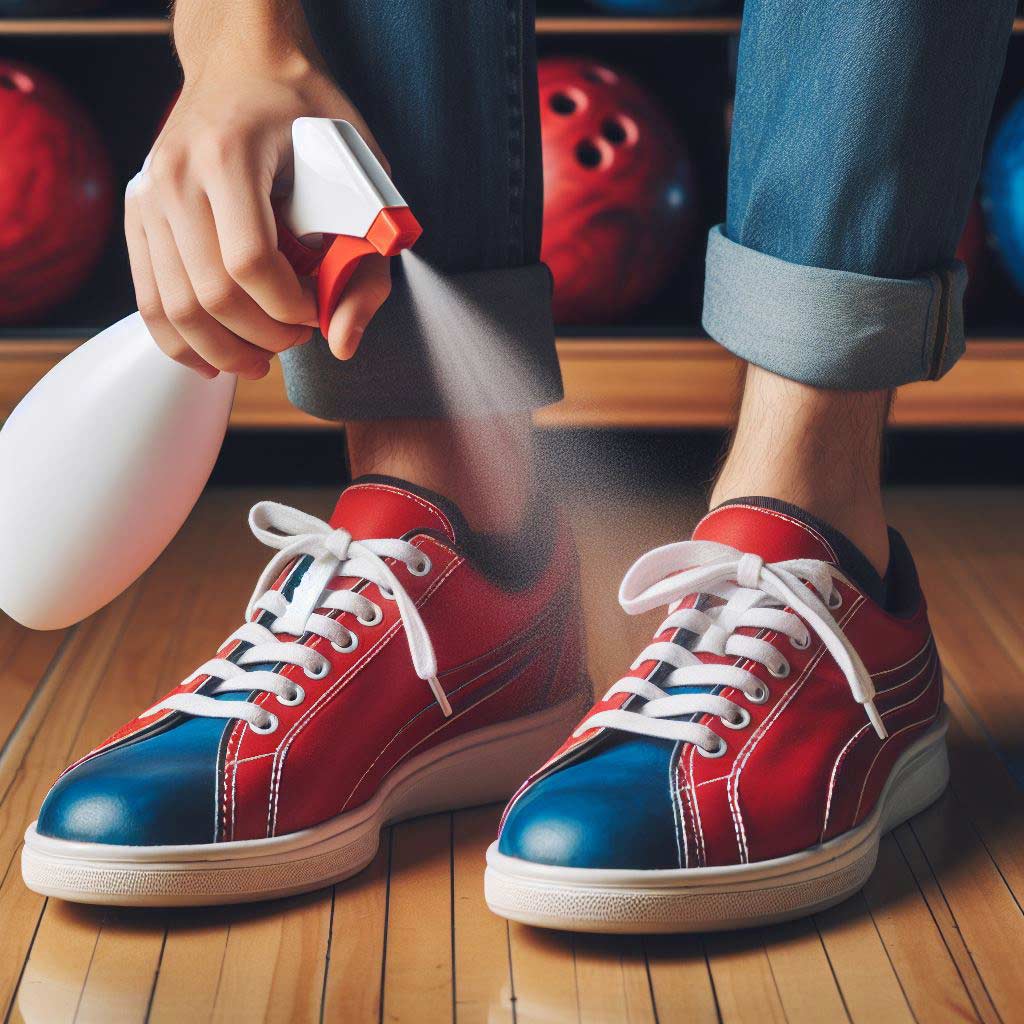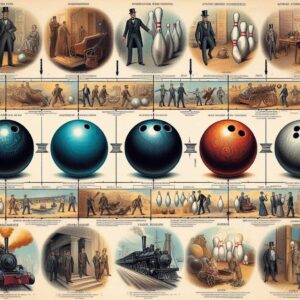The stale scent wafts up as you undo those slightly moist shoelaces and peel back the tongues. That familiar bowling alley shoe smell – it’s pungent and singular, calling to mind countless games gone by.
Beneath the odors accumulated from sockless feet past, you might detect a hint of something else as you bring the bowling shoes up to your nose and inhale…the cleansing sting of alcohol and chemicals. Proof these well-worn rentals have been sanitized since their last wearer.
But what exactly is that strong spray bowling alleys treat their shoes with between uses? And how effective is it at warding off the fungal and bacterial threats that come from so many different feet treading through game after game?
Let’s delve into the disinfecting agents used on bowling shoes, why alleys rely on them, and their power to protect your feet!
Bowling Shoes Are Breeding Grounds for Microbes and Germs
When you think about it, bowling shoes present the perfect conditions for microorganisms to thrive and spread. The inner lining soaks up sweat and flakes of dead skin in the warm, moist environment created by dozens of different feet and socks.
Meanwhile, the outer soles pick up bacteria and fungi from directly contacting the alley floors. Floors are also being trod upon by hundreds of different shoes each day.
According to a study published in the International Journal of Environmental Research and Public Health, researchers swabbed 30 rental bowling shoes to analyze the microbe populations living on them. They identified an average of more than 2,000 different species of bacteria on each bowling shoe sampled!
Some of the most abundant microbes detected included species of Pseudomonas, Proteus, and Bacillus. Many of these can cause skin infections and other ailments if allowed to over-colonize the feet.
Fungal species identified included Fusarium, which commonly causes athlete’s foot. Other prevalent fungi included the allergy-triggering genus Cryptococcus.
With such a diverse menagerie of microbes transferred from bowler to bowler through the shared shoes, effective disinfection between uses is a must!
Quaternary Ammonium – The Go-To Bowling Shoe Disinfectant
To combat the unseen threats posed by rental shoe microbes, most bowling alleys rely on spraying an antimicrobial solution between each wearer. This kills off considerable amounts of the fungal, viral, and bacterial accumulation without damaging the shoes.
The disinfecting agent of choice in most alleys is quaternary ammonium chloride, commonly abbreviated as “quats.” This chemical compound boasts strong antimicrobial properties, yet poses minimal risk of harming bowling shoe materials or users’ feet.
Many popular shoe spray products designed for bowling alleys contain quats as the primary active ingredient, including:
- Lysol Disinfectant Spray
- Clear Gear Sports Spray
- UltraLift Shoe Disinfectant Foam
Quats work by disrupting microbes’ membrane potentials. This makes it impossible for bacteria and fungi to generate the energy needed to survive and reproduce.
Most quats have a “one-two punch” against germs by also dissolving and stripping away lipids and proteins in microbial cell walls. This leads to complete cellular breakdown and death.
In addition to quats, many bowling shoe disinfectants include alcohol as a secondary sanitizing agent. This flashes off quickly after application to further inhibit microbial growth.
CDC Recommends Quats for Disinfecting Reusable Shoes
The widespread use of quaternary ammonium in bowling alley rentals is backed by science and health authority recommendations.
The CDC’s guidance for disinfecting reusable shoes at schools and businesses specifically recommends quats-based formulas. Products like Lysol or Clorox disinfecting sprays meet their criteria.
The CDC points to quats’ potent sanitizing ability coupled with their mildness as major advantages. Quats effectively kill dangerous fungal pathogens like athlete’s foot (tinea pedis). Yet they don’t degrade bowling shoe materials or irritate most people’s skin.
Another benefit of quats as bowling shoe disinfectant is their lasting residual effects. Once applied, quats continue inhibiting microbial growth for hours. This provides ongoing protection until the next spraying.
Of course, proper shoe maintenance requires more than just a quick spritz between games. Let’s look at some best practices…
Rotating Stock and Thorough Sanitization Keep Bowlers Safe
Responsible bowling alleys don’t rely on a fast squirt of Lysol alone to keep rented shoes in good shape. Conscientious alleys also incorporate these other hygienic measures:
- Allowing adequate drying time between uses – This ensures disinfectants evaporate fully so they don’t harm the next wearer’s feet.
- Using shoe sanitizing machines – Specialized equipment fills shoes with disinfecting fog to penetrate all crevices.
- Rotating shoe stock frequently – This allows shoes to undergo deeper cleanings while others remain in use.
- Disinfecting insoles – Insoles should be removed and sanitized regularly to prevent microbe buildup. New insoles may be provided to repeat customers.
- Airing shoes out – Leaving shoes to air out overnight removes foul odors. Ozone generators also help freshen.
- Following manufacturers’ instructions – Using disinfectants properly is vital for them to work. This includes allowing enough contact time.
- Adhering to CDC and OSHA guidelines – These include PPE for workers applying sprays, proper ventilation, etc.
- Training staff on procedures – Well-trained employees are key to consistent disinfecting standards.
With multiple complementary sanitizing methods combined with knowledgeable staff, bowling alleys can keep rented shoes hygienically sound for all patrons.
Controversies Over Bowling Shoe Cleanliness Still Linger
Despite modern understanding of germ theory and improved disinfecting techniques, concerns over bowling shoe hygiene still persist in the public imagination. Why is this?
Negative perceptions often come from visceral reactions to bowling shoes’ visible signs of wear. When people see tattered insoles or whiff odors wafting up, they assume the worst about microbial contamination.
Of course, the average person can’t actually see the armies of bacteria and fungi potentially marching across their feet. It’s an invisible threat they have to trust alleys to control, which breeds unease.
Outbreaks of fungal infections associated with bowling and skepticism over how thoroughly staff sanitize between uses feeds into this fear.
In 2015, for instance, a wave of tinea pedis (athlete’s foot) cases in Colorado led to investigation of several bowling centers over neglected disinfecting procedures. Though rare, such incidents damage public confidence.
How should the bowling industry overcome lingering notions that shared shoes aren’t clean enough? Through transparency, consumer education, and advancing standards.
The Future of Healthy Bowling Means Continued Vigilance
Bowling shoe disinfecting has come a long way since quats and Lysol first replaced straight bleach solutions. But there’s always room for improvement when public health is at stake.
Continuing innovation in shoe rental sanitization may include:
- Next-gen disinfectants – Newer quats formulas and alternate compounds like hydrogen peroxide mist.
- At-home disinfecting – Products to allow bowlers to further clean shoes themselves pre-game.
- Advanced deodorizing – Ozone and activated charcoal treatments to remove foul smells.
- Specialized machine washes – Powerful full shoe immersion washing units.
- Germicidal light exposure – UVC light has been shown to kill viruses and fungi.
- Hygienic liner options – Single-use disposable linings to separate feet from shoes.
- Self-serve kiosks – Reduced human contact for obtaining shoes.
- Updated guidelines – Stricter CDC and industry sanitization standards.
Through ongoing research and investments, bowling alleys can continue to allay concerns over rental shoe cleanliness. This will ensure the beloved pastime remains safe and healthy for generations of bowlers to come.
As for me personally? That nostalgic blast of astringent spray as I unbox my bowling shoes will keep comforting me that the alley’s got my feet’s back. Now to sit back, relax, and enjoy rolling for that elusive perfect game!
Frequently Asked Questions
What spray does bowling alleys use in shoes?
Most bowling alleys use a disinfectant spray containing quaternary ammonium, such as Lysol spray, to sanitize rental shoes between uses. The quaternary ammonium kills bacteria and fungi that can build up inside the shoes.
Why do they spray bowling shoes?
Bowling alleys spray rental shoes between wears to kill microbes like bacteria and fungi that can accumulate on people’s feet. It helps prevent the spread of foot infections like athlete’s foot.
Is it OK to spray Lysol in shoes?
Yes, Lysol and other quaternary ammonium disinfectants are recommended by the CDC for use in disinfecting reusable shoes. The chemicals are effective at killing microbes but relatively gentle on shoe materials.
Are bowling shoes sanitized?
Reputable bowling alleys sanitize rental shoes between each wearer by spraying them with disinfectant and allowing time to fully dry. Many also use additional shoe-cleaning methods like ozone treatments and sanitizing machines.
How do I make my new bowling shoes not so slippery?
To reduce slipperiness in new bowling shoes, have a professional put a deeper sole and heel into them to provide more traction. You can also apply bowling sole slider tape on slippery outsole spots.
How do I make my bowling shoes not stink?
To reduce odors and bacteria buildup in your bowling shoes, spray them with disinfectant after use, use deodorizing inserts or sprays, and stuff them with newspapers to absorb excess moisture.
Can you refuse bowling shoes?
Most bowling alleys will work to accommodate if you refuse standard rental shoes due to cleanliness concerns. Some options are disposable shoe liners, bringing your own shoes, or assigning you new or freshly cleaned shoes.
Can you get fungus from bowling shoes?
It’s possible to get fungal infections like athlete’s foot from the use of unclean bowling shoes. However, alleys that properly disinfect and sanitize their rental shoes between wears make this unlikely.
Why can’t you wear street shoes in bowling alley?
Bowling alleys prohibit outdoor shoes to prevent damage to lanes from dirt and grime. Street shoes also may not slide correctly on the lane approach. Rental shoes have special soles and are kept clean.





